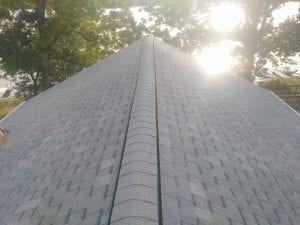
What is Roof Ventilation?
Roof ventilation serves to keep a roof at an even temperature. If your roof does not have an even temperature, ice dams can form during the winter from uneven thawing and freezing. This can damage your roof affecting its ability to properly insulate your home. Fortunately, most modern roofs have plenty of insulation which serves as a barrier to separate the living space from the underside of the roof making for an effective ventilation system. The insulation works to provide an air barrier to keep heat from flowing into the house and it helps to keep the roof sheathing cold.
What Type of Roof Ventilation is Best?
A soffit to ridge ventilation system is recommended as an effective way to keep roof sheathing cool. This system runs along the length of the house to provide the ultimate in ventilation. A baffled ridge vent is especially effective because it exhausts attic air regardless of the direction of the wind. The ridge vent creates exhaust pressure which sucks cold air into the attic through soffit vents. A 2-inch space or air chute can be created between the underside of the roof and the top of the insulation to provide a continuous flow of cool air. Other types of roof ventilation include power vents, turbines, roof vents and gable louvers.
Why Insulation is Important
Insulation is a key part of your roof’s ventilation system. It keeps your roof in good working condition while ensuring energy efficiency in the home. Houses that experience a variety of temperatures should be equipped with an insulation of at least R-38, which translates to about 12 inches of fiber and cellulose. The insulation should be continuous and of equal depth throughout. When it comes to making sure your house is properly insulated, the area above the exterior wall in critical.
Most new construction will be equipped with R-38 insulation over exterior walls. In existing structures, the space between the wall’s top plate and the underside of the roof sheathing may be restricted. In these cases, an R-6inch insulating foam should do the trick. The insulation should be sealed to prevent warm air from leaking into the living space.
The right roof ventilation will keep your roof in the best shape possible while keeping your home energy efficient. This will pay off in lower utility bills and reduced roof repair expenses. What steps will you be taking to make sure your roof is getting the proper ventilation? Let us help you achieve your roofing goals, schedule your free estimate today!
